A healthier choice? How juice vending machines like iJooz took over Singapore
Sign up now: Get ST's newsletters delivered to your inbox
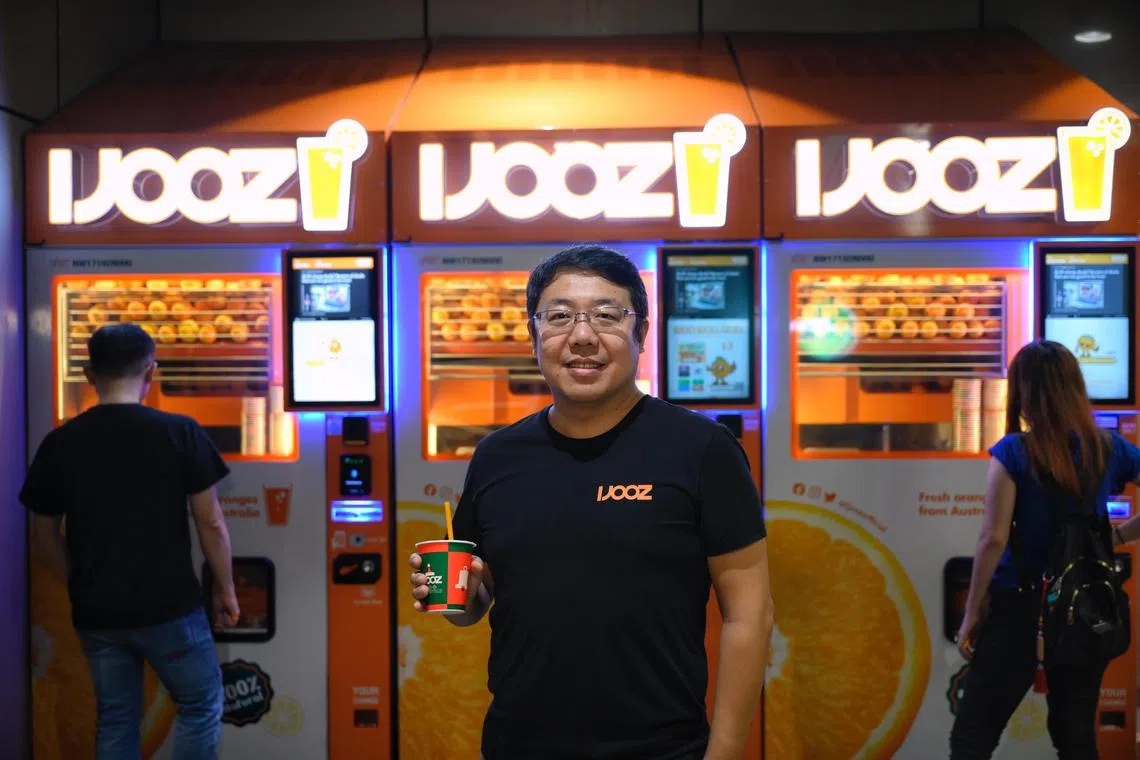
iJooz chief executive Bruce Zhang in front of a row of vending machines at Yishun Integrated Transport Hub on Dec 23, 2024.
ST PHOTO: MARK CHEONG
Follow topic:
SINGAPORE – Three things are guaranteed in life: death, taxes and an iJooz machine within a 1km radius of wherever you are in Singapore
Or at least that is what it sometimes feels like. The company, founded in 2016 by former engineer Bruce Zhang, has well and truly embedded itself into the everyday landscape, thanks to the installation of some 1,500 vending machines islandwide.
These orange-filled contraptions, which squeeze out fresh juice in minutes, are now so ubiquitous that some buildings, such as Yishun Integrated Transport Hub, have three on their premises. In other parts of Singapore, like Rangoon Road, they can be found on both sides of the street.
“You may feel like you see iJooz everywhere, but sometimes when you want a cup, you realise that there isn’t one close enough to walk to. So, we need more machines,” says Mr Zhang, 42.
The goal of iJooz’s chief executive is to eventually have 5,000 machines in Singapore, with a handful possibly planted at HDB void decks – an untapped area of potential for the company.
Most of iJooz’s orange juice dispensers are located at train stations, bus interchanges and malls. It is pretty much the only vending machine selling this product left in Singapore, having eclipsed competitors such as Q Orange, which has all but exited the local market.
These days, competition comes in the form of other automated juicers instead.
For instance, the boxy green contraption that juices sugarcanes on demand. These Fresh & Pure vending machines can now be found near iJooz’s distinctive orange and white dispensers at some malls.
Elsewhere, machines selling smoothies blended on the spot have cropped up in Suntec City, Bugis+ and Mount Elizabeth Hospital. Stocked with tubes of frozen fruit, they churn out creamy combinations such as strawberry-banana and papaya-mango milkshakes that busy office workers can grab on the go.
These smart juicers join other speciality food vending machines
An accessible side hustle
iJooz may be the dominant player in the vending machine market, but the newer juicing entrants are not cowed. On the contrary, they see the brand’s success as a beacon of hope.
“iJooz is a good role model for us. We want at least 300 machines in Singapore and, eventually, to expand overseas,” says Mr Mukul Bhardwaj, the 29-year-old founder of Hale Smoothies, which was first deployed in 2022. He has three machines, and plans to deploy another 30 by the end of 2025.
Likewise, Mr Ting Shi Yang, the 43-year-old founder of Fresh & Pure, was inspired by iJooz’s popularity. “It’s nice that they offer another healthy option for customers. But what we have is unique, so I don’t think we’re operating in an over-saturated market,” he says.

Mr Ting Shi Yang launched sugarcane dispenser Fresh & Pure to earn extra income during the Covid-19 pandemic.
ST PHOTO: NG SOR LUAN
He has no plans to replace hawkers selling fruit juice either. “Their customers are those who are dining at hawker centres, but we target people in the city centre who don’t have immediate access to a hawker centre or foodcourt. Or maybe they’re craving sugarcane juice, but the hawker centre is closed, that’s when they turn to our machines.”
Mr Ting, a real estate agent by day, refined his prototype during the Covid-19 pandemic, when he had time on his hands.
“I thought sugarcane juice had a lot of potential because it’s something that every Singaporean knows and loves. At the same time, it’s also something that might appeal to tourists.”
Together with his father, fellow property agent Ting Mun Thow, 67, he developed a prototype with a manufacturer in China, launching the first Fresh & Pure machine in Upper Boon Keng in 2020. The company now has 40 machines, each costing around $18,000, across Singapore, mainly in the central area. It hopes to install a total of 500 by 2027.
Mr Bhardwaj also started Hale Smoothies as a side hustle. Having grown up helping out in his parents’ Indian restaurant in Upper Thomson Road, he is no stranger to the difficulties that plague the industry.
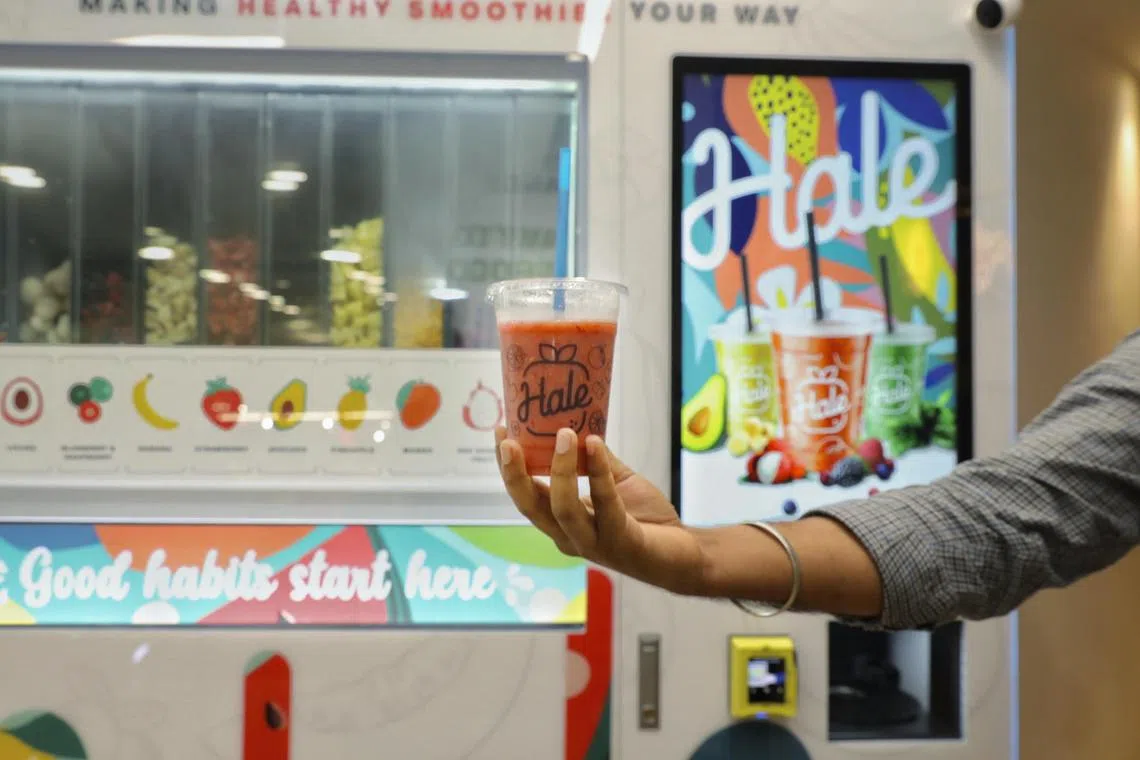
Hale Smoothies was founded by Mr Mukul Bhardwaj to offer consumers healthy alternatives to soft drinks.
ST PHOTO: TARYN NG
He regards vending machines, with their lower manpower demands and cheaper rent, as a more viable alternative to traditional eateries.
A successful restaurant has a profit margin of up to 15 per cent, with most earnings falling between the 3 to 5 per cent range. In contrast, his machines, which cost around $30,000 each, yield a 42 per cent net profit.
In addition to the price of hardware, owners also have to factor in ingredient costs and manpower to regularly maintain, clean and refill the machines. For instance, Mr Ting has a team of five helping to maintain his sugarcane vending machines. They require daily top-ups, unlike a machine dispensing non-perishables, which can be restocked every two or three days.
Mr Bhardwaj says: “We’re in an era when automation no longer decreases profitability. In fact, you can use it to bring down costs drastically.”
Is fruit juice healthier?
Mr Bhardwaj, who has a diploma in aerospace engineering from Temasek Polytechnic, spent four years on research and development alone, customising every last bit of his vending machine, down to the blender blades.
He also cycled through more than 160 recipes, which were tested over 12 focus group discussions. He even roped in chefs from neighbouring restaurants in the Upper Thomson belt to offer feedback.
What he was looking for were smoothies that would taste good without the addition of sugar or honey, though those options are still available for customers with a sweet tooth.
“We try to be as transparent as possible. Customers can see the fruit being dispensed into their cup,” he says.
There is just one final step that happens out of sight – the addition of milk or water. But Mr Bhardwaj is working on an upgrade that will make this part of the process visible too. “With a regular smoothie kiosk, you have someone behind the counter. But here, it’s just the machine. So, this transparency is super important, as it helps build trust.”

Hale Smoothies allows customers to see how their smoothie is made. A weighted amount of frozen fruit falls into the cup when an order is placed.
ST PHOTO: TARYN NG
He prides himself on how healthy Hale Smoothies’ drinks are, just like Mr Ting and Mr Zhang, who emphasise that their products are free from added sugar.
Mr Zhang says: “If we added sugar, every cup would taste the same, but some are clearly more sour than others.”
He adds that the company randomly samples its oranges to check the sweetness and acidity of each batch.
The growing popularity of these vending machines reflects a shift towards convenience-driven health choices, says Ms Loh Win Nie, a senior lecturer specialising in food nutrition and culinary science at Temasek Polytechnic.
However, she cautions that these fruit juices or smoothies, no matter how pure, might not be as healthy as sometimes assumed. While they provide essential nutrients such as vitamins, minerals and antioxidants, a single cup could contain the juice of multiple fruits, making it more concentrated in natural sugars and calories.
“For example, a glass of orange juice may be made from three to four oranges, whereas eating a whole orange with its fibre would be far more filling and have fewer calories per serving. Without dietary fibre, the juice is less satiating, which can lead to consuming more calories than intended,” adds Ms Loh, who is also vice-president of the Singapore Nutrition and Dietetics Association.
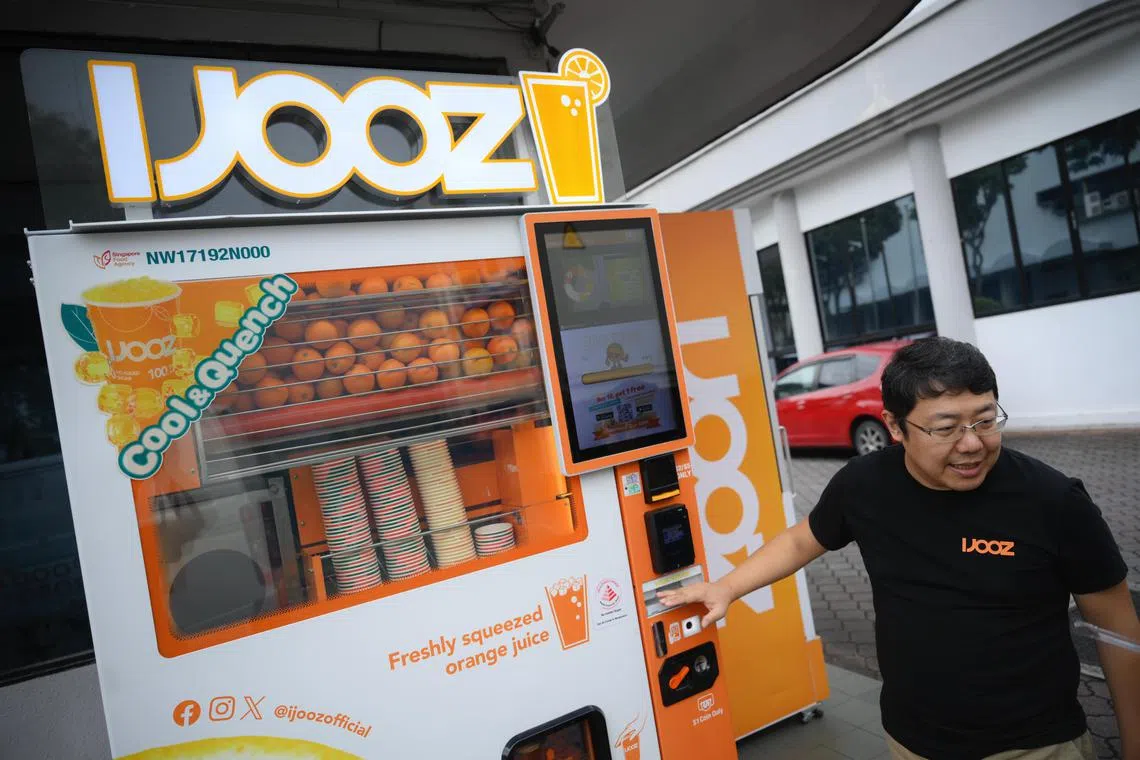
iJooz’s fifth-generation vending machines will include pulp in its orange juice and offer customers the option of adding ice.
ST PHOTO: MARK CHEONG
Dr Heng Kiang Soon, a lecturer at Republic Polytechnic’s School of Applied Science, suggests blending rather than cold-pressing fruit, as iJooz and Fresh & Pure do.
“As pulp is removed from juicing, some of the nutrients may be trapped in the fruit pulp. Therefore, the better way is blending rather than juicing, as it keeps the nutrients in the serving of the blend,” he says.
“Less waste would be generated when all edible parts of the fruit are blended into the smoothie.”
According to Mr Zhang, iJooz is rolling out a new version of its machine that will add pulp to its orange juice. There are 50 such fifth-generation machines, the cost of which he declines to reveal, around Singapore at the moment.
Keeping pests out
Ms Grace Tan, 39, and her 43-year-old husband Derek Gue have taken the opposite approach. Instead of specialising in one product and constantly refining it, they follow wherever the trends of the day lead.
They manage a portfolio of more than 50 vending machines – most of which are rented out – which sell a range of in-demand wares from Labubu toys to Prime drinks.
The one thing they will not touch? Fresh fruit.
“It generates a lot of wastage,” says Ms Tan, adding that she is wary of single-product vending machines because they do not survive long.
“And for any machine that easily attracts pests, you’re kept on your toes all the time. Imagine the buzz that will happen should a rat, cockroach or lizard appear in the machine. People will upload videos to social media faster than you can say ‘TikTok’.”
Such a fate indeed befell Q Orange. Videos of flies in its orange juice vending machines were uploaded to Reddit in 2020, while reports of mouldy oranges in its dispensers made their rounds online in 2021, precipitating the downfall of the Singapore-based brand, which may have helped to pave the way for iJooz’s dominance.
“iJooz was both strategic in its planning and somewhat lucky in market timing to ride the wave of doubt of other players’ product hygiene, where iJooz assured customers of its hygiene standards through its technology at a time when consumer trust were shaken by reports of mould in competitors’ juice vending machines,” says Dr Hannah H. Chang, associate professor of marketing at the Singapore Management University.
Mr Zhang says his machines maintain an internal temperature of 4 deg C and that any parts that come into contact with the fruit are replaced and washed back at base when the oranges are refilled.
Similarly, Fresh & Pure’s sugarcanes are kept in a temperature-controlled environment of up to 8 deg C. They are replaced daily and any contaminated parts are cleaned at a central area.
“Our drinks might be more hygienic than what you find in a hawker centre because there’s no human touch until the drink is served,” Mr Ting says.
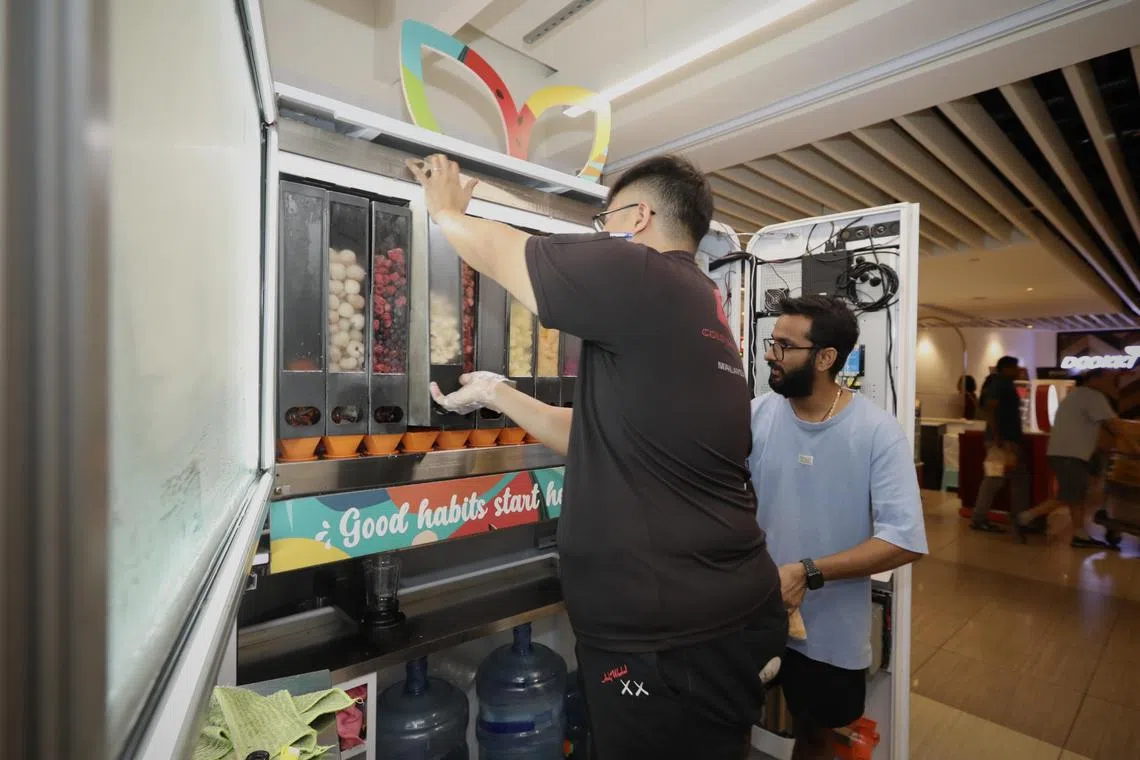
Staff restocking one of Hale Smoothies’ vending machines. The machines are cleaned twice daily.
ST PHOTO: TARYN NG
Hale Smoothies’ machines, on the other hand, are equipped with a self-cleaning function that washes the blades after every cycle, but the rest of the machine is spruced up each morning and night. An external pest control team comes down once a week to inspect and treat the surrounding area.
Still, there are certain signs customers can look out for to make sure their drink is safe for consumption.
Ms Emma Choondee, a food, nutrition and culinary science lecturer from Temasek Polytechnic, advises customers to avoid juices with an unusual colour, gas or bubbles. Look out for sour smells or off-putting aromas, which can be a sign of bacteria growth, adds Mr Aaron Chua, a lecturer at Republic Polytechnic’s school of hospitality.
The price is right
Health benefits and safety precautions can help to entice customers to part with their money, but the main draw of these vending machines is their price point, say experts.
iJooz’s orange juice retails for $2 a cup – though some are sold at $3 due to requirements from landlords – while Fresh & Pure prices its sugarcane drinks at $2.50. In comparison, juice sold at hawker centres and foodcourts usually costs $1.50 to $2.50.
Hale Smoothies’ offerings, meanwhile, start at $5 for a 500ml banana, strawberry, blueberry, raspberry and mango smoothie. It is slightly cheaper than brands with kiosks like Boost, which prices its smoothies at $6.50 and above for a 500ml cup.
Mr Bhardwaj claims that his smoothies, which contain no additives like nectar, yogurt or ice, are made with more fruit and offer a better deal. Each machine sells around 70 to 80 cups a day.
On the other hand, iJooz’s top-performing machines can sell up to 400 cups a day, while some of Fresh & Pure’s dispensers rack up 100 to 150 cups daily.
“Going forward, iJooz’s long-term success may hinge on its ability to deliver consistent quality at an appealing price point, backed by robust quality assurance and supply chain for sourcing and distribution to ensure freshness,” says Dr Chang.
This, however, might prove difficult. Climate change has upset the supply of oranges, for instance, and sent prices skyrocketing. The cost of the fruit has surged by more than 50 per cent since 2016 – from 43 to 66 cents each – according to data from Singapore’s Department of Statistics.
So, Mr Zhang cannot promise that the price of juice will remain at $2 in the coming years, though he notes that iJooz has not raised prices since 2016.
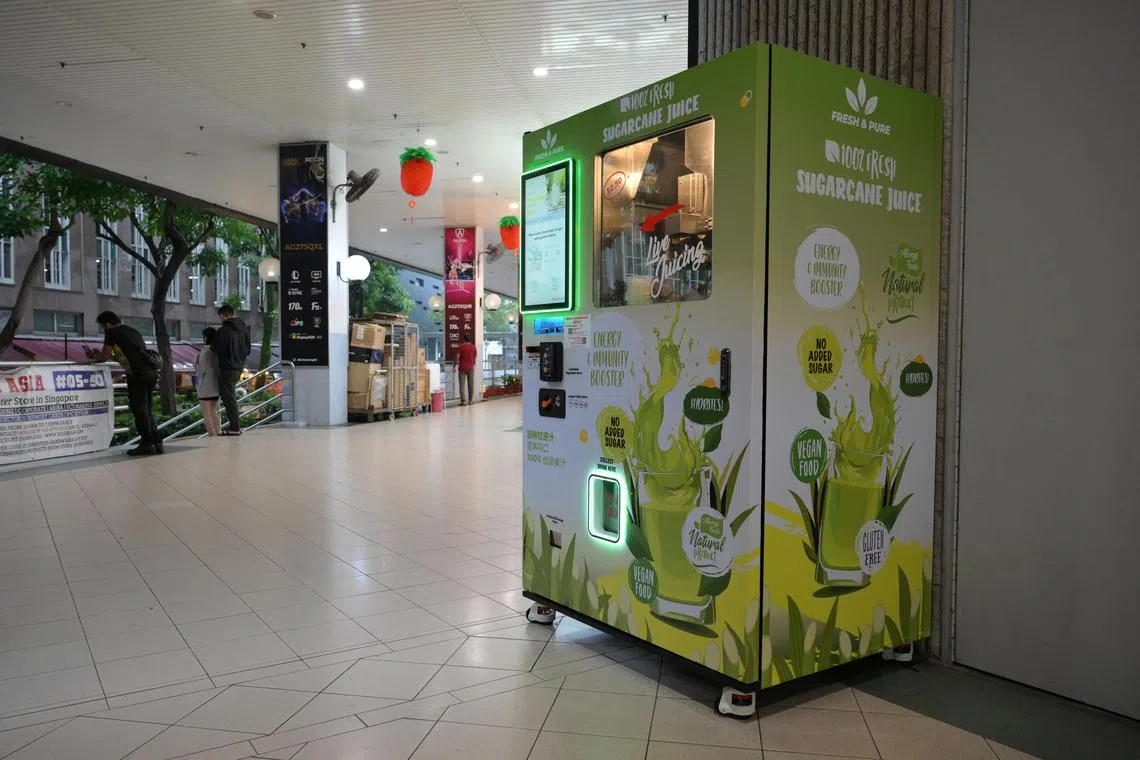
Fresh & Pure’s best performing machines are located in central Singapore.
ST PHOTO: NG SOR LUAN
Fresh & Pure’s Mr Ting is also feeling the bite of inflation, with raw material costs doubling over the last five years. The company had to bump up the cost of each cup from $2 to $2.50 in 2024 to cope with rising expenditure.
However, he says products in certain areas like Geylang are still capped at $2 to ensure lower-income customers – like migrant workers in search of some relief from the heat – can continue to enjoy freshly pressed sugarcane juice at affordable prices.


